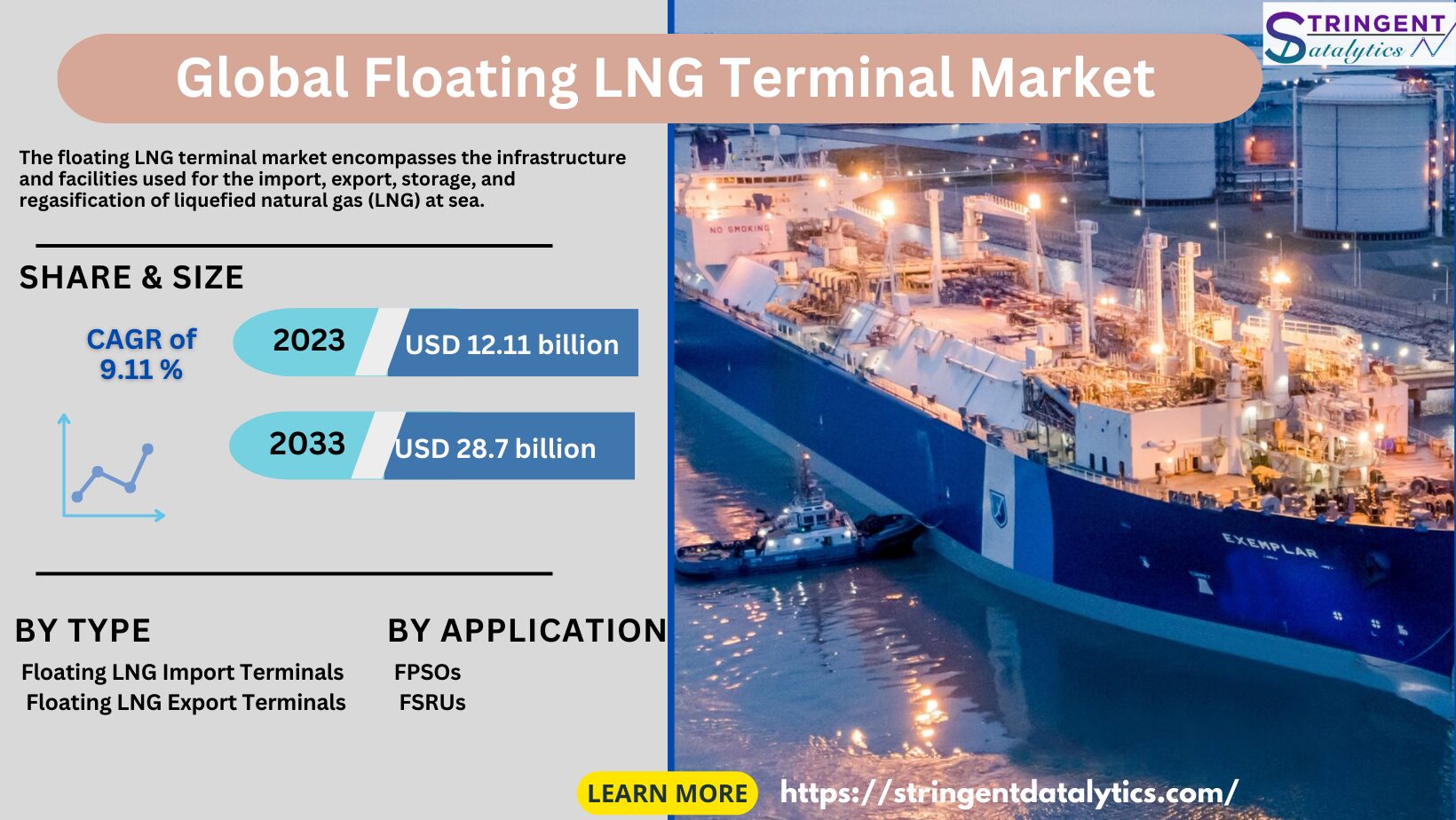The floating LNG terminal market was valued at USD 12.11 billion at 2023 to reaching at USD 28.7 billion by the end of 2033. Expected to grow at a CAGR of 9.11% from 2024–2033
Introduction
The Floating LNG (FLNG) terminal market has seen significant growth and transformation over recent years, driven by increasing global energy demands, the shift towards cleaner energy sources, and technological advancements. FLNG terminals enable the liquefaction, storage, and offloading of natural gas at sea, providing a flexible and cost-effective solution compared to onshore facilities.
Market Analysis
The FLNG market is expanding, with several key players and regions driving growth. The major players include Shell, Petronas, and Golar LNG, among others. Regions such as Asia-Pacific, the Middle East, and Africa are significant markets due to their growing energy needs and offshore gas reserves.
Key Market Drivers:
- Increasing Global Energy Demand: Rising energy consumption, especially in emerging economies, fuels the demand for LNG.
- Environmental Regulations: Stricter environmental policies and the push for cleaner energy sources boost the FLNG market.
- Technological Advancements: Innovations in FLNG technology improve efficiency and reduce costs, making it a more attractive option.
- Geopolitical Factors: Diversification of energy sources to reduce dependency on specific regions also supports market growth.
Challenges:
- High Initial Costs: The initial investment for FLNG projects is substantial.
- Technical and Operational Risks: Operating in offshore environments poses significant challenges.
- Regulatory Hurdles: Navigating the complex regulatory frameworks across different countries can be daunting.
Key Trends and Factors
- Technological Innovations: Advancements in liquefaction technology, cryogenic systems, and modular construction are key trends. These innovations enhance the efficiency and reduce the costs of FLNG terminals.
- Floating Storage and Regasification Units (FSRUs): The use of FSRUs is growing, offering a flexible and faster deployment option compared to traditional onshore regasification terminals.
- Partnerships and Collaborations: Increasing collaborations between energy companies and technology providers drive the development and deployment of FLNG projects.
- Sustainability Initiatives: The industry is focusing on reducing carbon footprints, with new technologies aimed at minimizing greenhouse gas emissions during LNG production and transport.
Working and Technology
FLNG Working Mechanism:
- Gas Extraction: Natural gas is extracted from offshore gas fields.
- Liquefaction: The gas is cooled to -162°C (-260°F) to convert it into a liquid state, reducing its volume by approximately 600 times.
- Storage: The liquefied gas is stored in insulated tanks on the FLNG vessel.
- Offloading: LNG is offloaded to LNG carriers for transportation to markets or to FSRUs for regasification and delivery to onshore pipelines.
Key Technologies:
- Liquefaction Technology: Includes mixed refrigerant processes and cascade refrigeration systems.
- Cryogenic Systems: Essential for maintaining LNG at extremely low temperatures.
- Modular Construction: Enables the prefabrication of components, reducing construction time and costs.
- Advanced Materials: Use of materials that can withstand harsh offshore conditions.
Receive the FREE Sample Report of Floating LNG Terminal Market Research Insights @ https://stringentdatalytics.com/sample-request/floating-lng-terminal-market/14959/
Market Segmentations:
Global Floating LNG Terminal Market: By Company
Royal Dutch Shell
Excelerate Energy
Samsung Heavy Industries
Golar LNG and Höegh LNG
Daewoo Shipbuilding and Marine Engineering
PETRONAS
Hyundai Heavy Industries
Global Floating LNG Terminal Market: By Type
Floating LNG Import Terminals
Floating LNG Export Terminals
Global Floating LNG Terminal Market: By Application
FPSOs
FSRUs
Regional Analysis of Global Floating LNG Terminal Market
All the regional segmentation has been studied based on recent and future trends, and the market is forecasted throughout the prediction period. The countries covered in the regional analysis of the Global Floating LNG Terminal market report are U.S., Canada, and Mexico in North America, Germany, France, U.K., Russia, Italy, Spain, Turkey, Netherlands, Switzerland, Belgium, and Rest of Europe in Europe, Singapore, Malaysia, Australia, Thailand, Indonesia, Philippines, China, Japan, India, South Korea, Rest of Asia-Pacific (APAC) in the Asia-Pacific (APAC), Saudi Arabia, U.A.E, South Africa, Egypt, Israel, Rest of Middle East and Africa (MEA) as a part of Middle East and Africa (MEA), and Argentina, Brazil, and Rest of South America as part of South America.
Click to Purchase Floating LNG Terminal Market Research Report @ https://stringentdatalytics.com/purchase/floating-lng-terminal-market/14959/?license=single
Historical Developments
Early Concepts:
- The FLNG concept emerged in the 1970s, but technological and economic barriers delayed its development.
Significant Milestones:
- 2007: Shell announced the Prelude FLNG project, the world’s first FLNG facility.
- 2016: Prelude FLNG was completed and deployed off the coast of Australia, marking a major milestone.
- Recent Developments: Several FLNG projects have been initiated worldwide, with increased investment in technology and infrastructure.
Objective
The primary objective of FLNG terminals is to provide a flexible, cost-effective, and environmentally friendly solution for the liquefaction, storage, and transportation of natural gas. By operating offshore, FLNG terminals reduce the need for extensive onshore infrastructure, minimize environmental impact, and offer a scalable solution to meet the rising global demand for LNG.
About Stringent Datalytics
Stringent Datalytics offers both custom and syndicated market research reports. Custom market research reports are tailored to a specific client’s needs and requirements. These reports provide unique insights into a particular industry or market segment and can help businesses make informed decisions about their strategies and operations.
Syndicated market research reports, on the other hand, are pre-existing reports that are available for purchase by multiple clients. These reports are often produced on a regular basis, such as annually or quarterly, and cover a broad range of industries and market segments. Syndicated reports provide clients with insights into industry trends, market sizes, and competitive landscapes. By offering both custom and syndicated reports, Stringent Datalytics can provide clients with a range of market research solutions that can be customized to their specific needs.
Reach US
Stringent Datalytics
+1 346 666 6655
Social Channels:




Leave a Reply